Family : Pomacentridae

Text © Giuseppe Mazza

English translation by Mario Beltramini
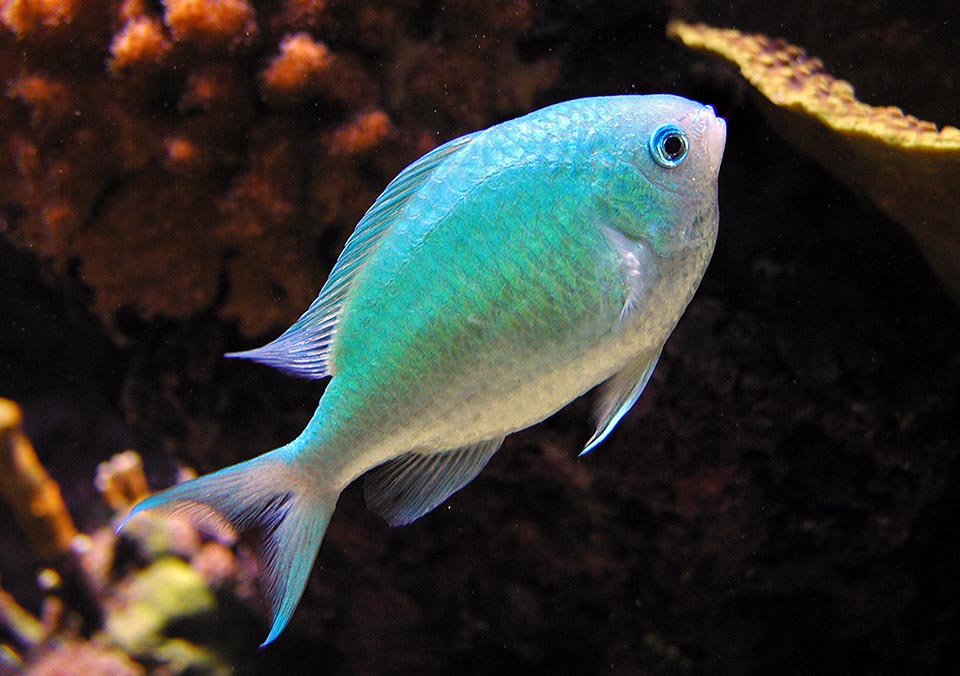
9-10 cm long at most, Chromis viridis is frequent in the waters of tropical Indo-Pacific © Giuseppe Mazza
The Blue green damselfish or Green chromis (Chromis viridis Cuvier, 1830), belongs to the class of the Actinopterygii, the ray-finned fishes, to the order of Perciformes and to the family of Pomacentridae, which counts about thirty genera and almost 400 species, practically all tropical, but rare exceptions such as our Damselfish (Chromis chromis) of the Mediterranean.
The name of the genus is that of a not well identified fish cited by Aristotle and assigned, as we have seen, by Linnaeus to our damselfish. A successful genus, which has about 95 species, about one fourth of all combined species of Pomacentridae.
The name of the species, “viridis” = green in Latin, is, on the contrary, unambiguous.
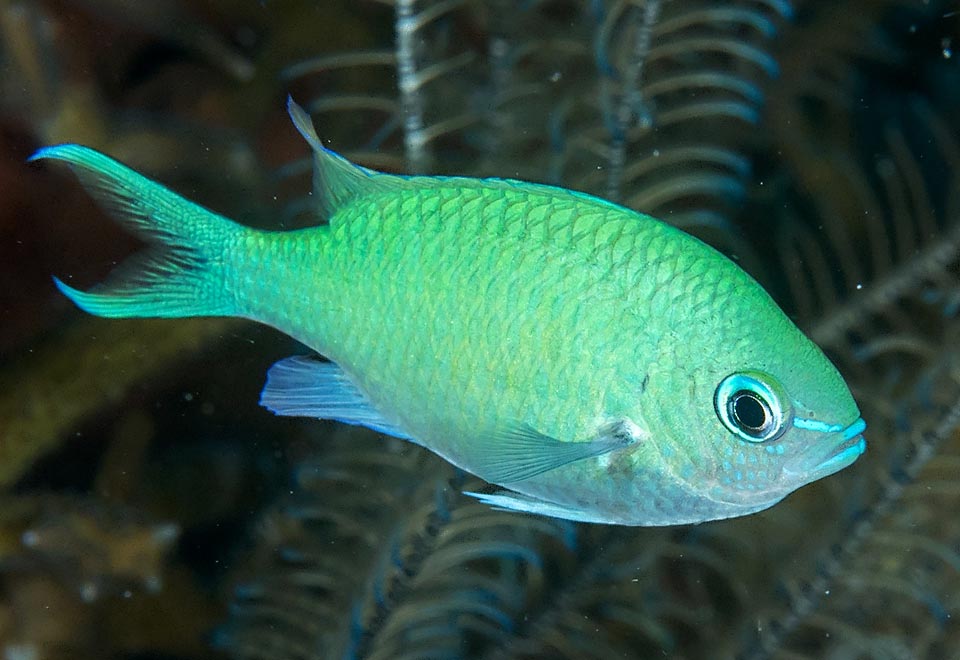
The livery is sparkling and constantly changes from green and blue, on the light inclination, hence the name of Blue green damselfish or Green chromis © Rickard Zerpe
Zoogeography
It has a very vast distribution in the tropical waters of the Indian and Pacific oceans.
We find it, indicatively, from East Africa and Madagascar to the Red Sea, the Seychelles, Mauritius, Réunion, the Maldives, India, Sri Lanka, Australia, Indonesia, Micronesia, New Guinea, Palau, the Philippines, Taiwan, China and in the islands of Ogasawara and Ryukyu in the southern part of Japan. Eastward, it has colonized the Fiji Islands, Samoa, Tonga, Kiribati, Tuamotu and Pitcairn, which represent also the southern limit in the Pacific after the Great Barrier Reef and New Caledonia.
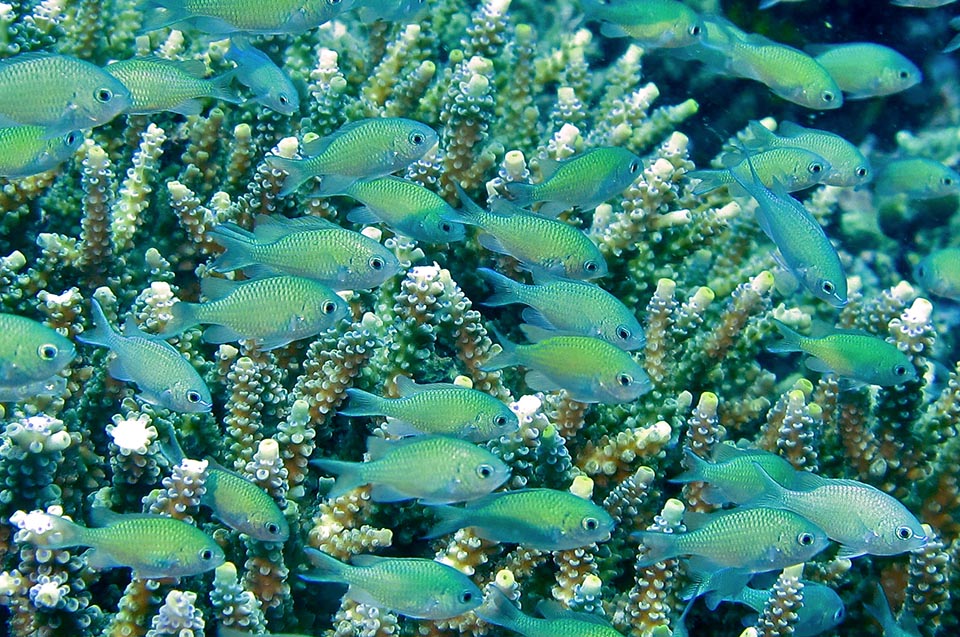
It lives in small schools sheltering from predators in prickly branches of madrepores of the genus Acropora © Bernard Dupont
Ecology-Habitat
It lives in the lagoons, but also on the outer side of the reefs, in relatively calm and shallow waters up to about 12 m of depth. It s strictly linked to the madrepores, especially those belonging to the genus Acropora, next to which it swims, in small schools, ready to disappear among the branches at the least sign of danger. It does not love the dead corals, and therefore avoids the degraded zones.
Morpho-physiology
The blue green damselfish reaches the 9-10 cm. The body, high and flat, almond-shaped, shows one dorsal fin with 12 spiny rays and 9-11 soft; the anal has 2 spiny rays and 9-11 unarmed; the ventral ones are pointed, the pectoral ample with 17-18 unarmed rays and the caudal is decidedly bifurcate, swallow-tailed.
The protractile mouth is armed with caniniform teeth. The eyes are relatively large.
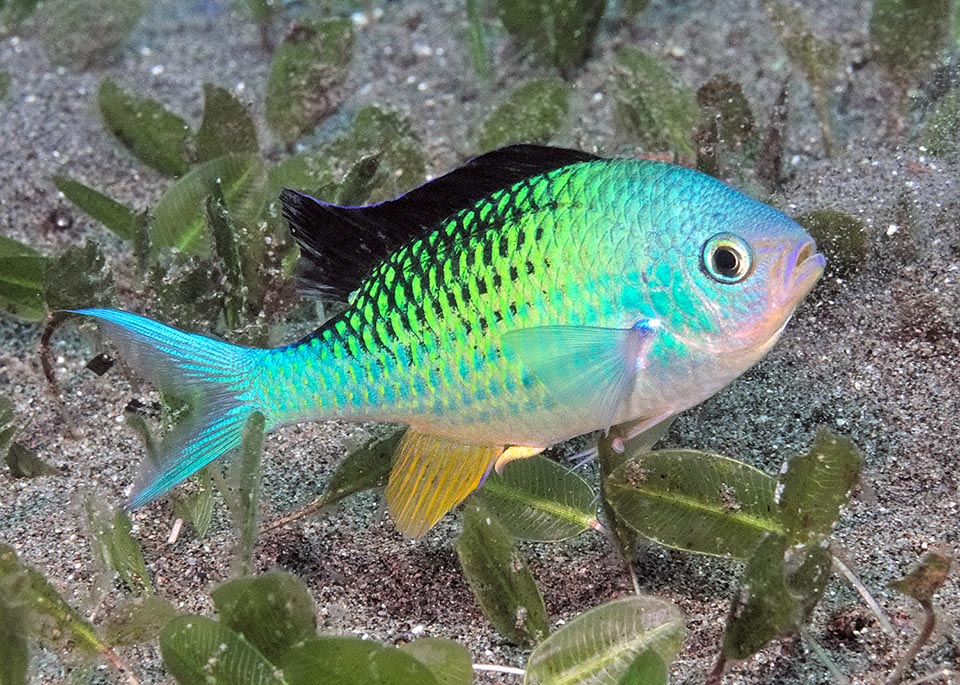
Male in nuptial livery. Even if the school reproduces at the same time, the sperm is not released in the sea. The fecundation occurs in couple © Klaus Stiefel
But what is more striking is the bright blue turquoise livery, with electrical shades, changing unabated between the green and the blue depending on the inclination of the light. The abdomen is paler, at times with yellowish hues.
Ethology-Reproductive Biology
The blue green damselfish is omnivorous. It nourishes of phytoplankton and of zooplankton. It quietly sucks the algae, the eggs and the larvae of fish carried by the currents, but for the faster organism, like the crustaceans, which might run away, extends and closes the mouth with the speed of a lightning, in a few thousandths of a second.
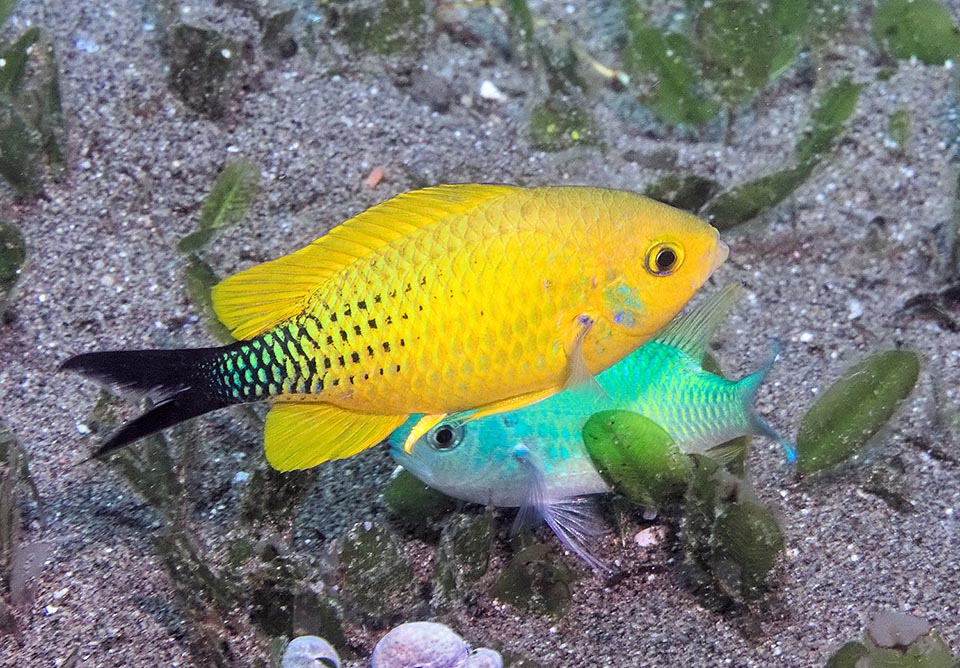
The nuptial livery may also be yellow. This skilled seducer has found a partner at once. It digs a hole for the eggs and fecundates them © Klaus Stiefel
The marriages are a pair matter, but they take place grouped. The males chose for the nest, a small dimple dug in the sand, the dead branch of madrepora or simply, one hospitable seaweed. Then they dance, moving up and down, like if they were jumping inside a virtual column of water, for attracting the attention of the females and show the competitors that is their place.
The female enters the column for a synchronized dance, but does not spawn immediately. Only later on, when they are well together, it fixes the eggs to the substratum in the indicated place and the male fecundates them. Once the ceremony is over, it comes back to the every day life, whilst the male tries to attract another female. When the nest is overflowing of eggs, about half a millimetre wide, it calms down and keeps watch for 2-3 days, till the hatching, ventilating them and eating the non fecundated ones which are getting rotten.
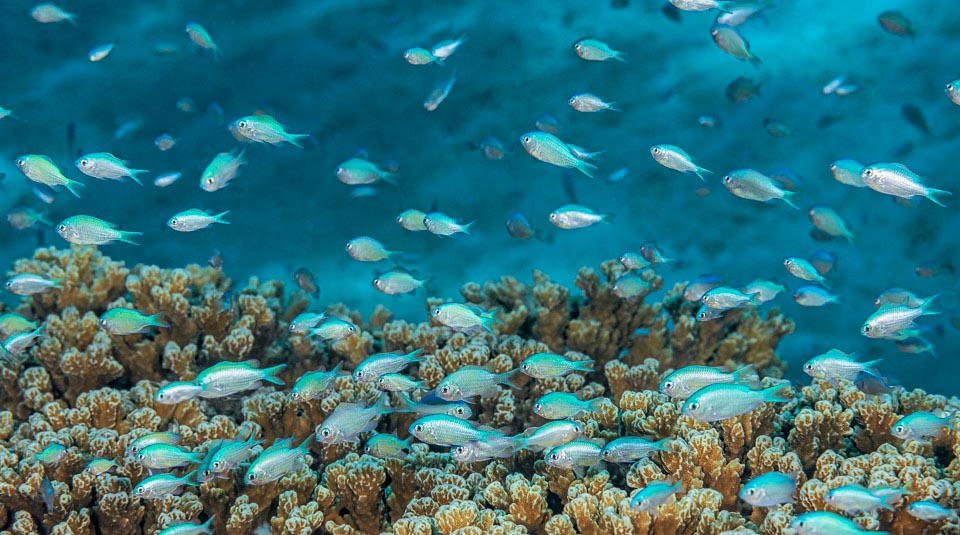
School of juveniles. They will soon learn that they are safe among the arms of the Acropora © François Libert
The larvae, about 2 mm long, carry on pelagic life for 3-4 weeks. Then the juveniles, led by the olfactory signals emitted by the available madrepores, colonize them, sheltering at the centre of their ramifications. When they go up they find more plankton risking being predated, but if they keep low, where there is little current and the coral polyps have already done the lion’s share, they risk dying starving.
The resilience of the species is good, seen that the members can double in less than 15 months, and the fishing vulnerability index is surely low: only 10 on a scale of 100.
Synonyms
Heliases frenatus Cuvier, 1830; Heliases lepisurus Cuvier, 1830; Pomacentrus viridis Cuvier, 1830; Dascyllus cyanurus Rüppell, 1838; Glyphisodon bandanensis Bleeker, 1851.
→ For general information about FISH please click here.
→ For general information about BONY FISH please click here
→ For general information about CARTILAGINOUS FISH please click here.
→ To appreciate the BIODIVERSITY of BONY FISH please click here.
→ To appreciate the BIODIVERSITY of CARTILAGINOUS FISH please click here.
